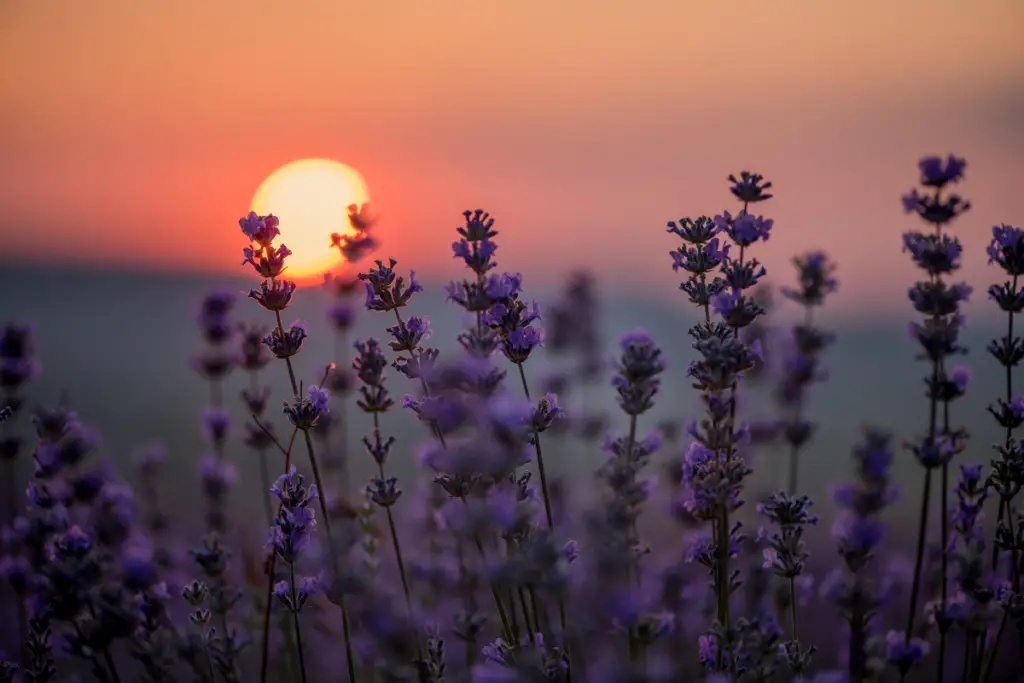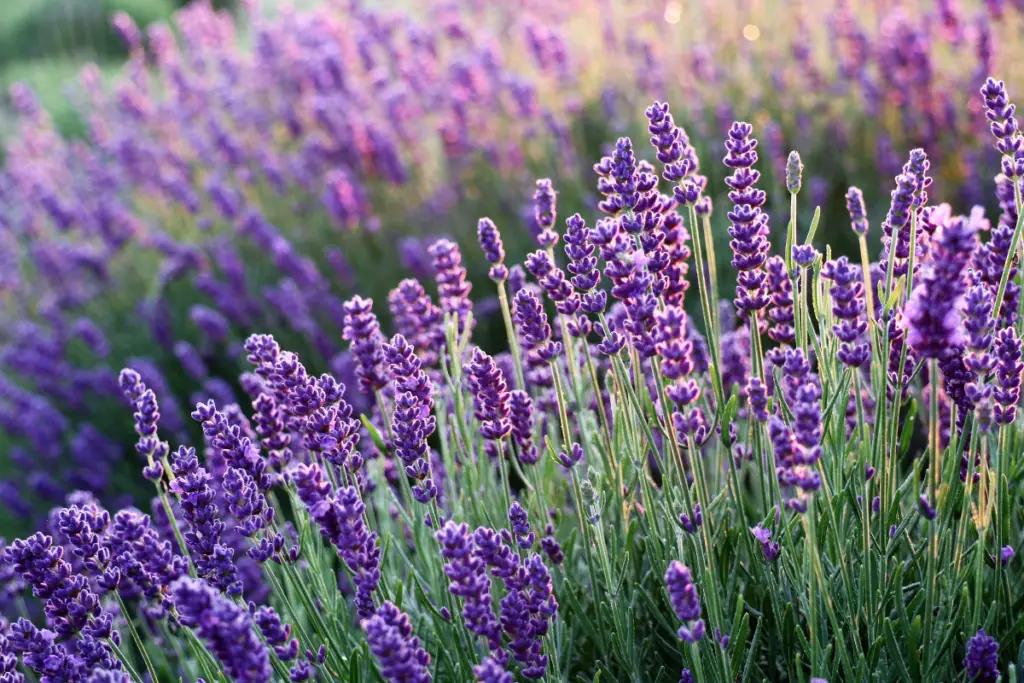Lavender is a popular herb that is well-known for its sweet fragrance and beautiful purple flowers. It is used for a variety of purposes, from aromatherapy to culinary applications.
However, for those who are interested in growing lavender, the question of how long it takes to grow is an important one.
The answer to this question depends on several factors, including the type of lavender being grown, the growing conditions, and the care provided to the plant.
Some varieties of lavender can take up to three years to reach full maturity, while others can grow to their full size in as little as one year.
Additionally, the growth rate of lavender can be affected by factors such as temperature, soil quality, and watering practices.

Table of Contents
Understanding Lavender
Lavender (Lavandula spp.) is a popular perennial shrub known for its fragrant flowers and medicinal properties.
It is native to the Mediterranean region and is widely cultivated for its essential oil, which is used in perfumes, soaps, and other beauty products.
Lavender is also a popular ornamental plant in gardens and landscapes due to its attractive foliage and flowers.
Lavender plants typically grow to a height of 1-3 feet and have narrow, gray-green leaves. The flowers are arranged in spikes and come in a range of colors, including purple, pink, and white.
The plant blooms in late spring to early summer and can continue to flower throughout the summer months.
Lavender is a hardy plant that can grow in a variety of soil types, as long as they are well-drained.
It requires full sun and can tolerate drought conditions, making it an ideal plant for dry and arid regions.
However, it is susceptible to root rot if the soil is too wet, so it is important to avoid overwatering.
Lavender plants can take anywhere from one to five years to reach full maturity, depending on the variety and growing conditions.
During the first year, the plant will establish its roots and produce a small amount of foliage.
In the second year, it will begin to produce more foliage and may start to flower.
By the third year, the plant should be well-established and producing a significant amount of foliage and flowers.
Overall, lavender is a versatile and attractive plant that is easy to grow and care for. It is a great addition to any garden or landscape and can be used for a variety of purposes, from aromatherapy to culinary applications.
The Lavender Life Cycle
Lavender is a perennial plant that goes through several distinct stages during its life cycle.
Understanding these stages is essential for growing healthy and productive lavender plants.
The four primary stages of the lavender life cycle are germination, vegetative growth, flowering, and dormancy.
Germination Stage
The germination stage is the first stage in the life cycle of lavender. During this stage, the seeds sprout and develop into seedlings.
Lavender seeds require warm temperatures and well-draining soil to germinate successfully. It can take anywhere from 14 to 30 days for lavender seeds to germinate, depending on the variety and growing conditions.
Vegetative Stage
The vegetative stage is the second stage in the lavender life cycle. During this stage, the plant focuses on developing its root system and growing foliage.
Lavender plants require full sun and well-draining soil to thrive during the vegetative stage.
The length of the vegetative stage can vary depending on the growing conditions and the variety of lavender.
Flowering Stage
The flowering stage is the most critical stage in the lavender life cycle. During this stage, the plant produces fragrant flowers that are harvested for culinary, medicinal, and ornamental purposes.
The flowering stage typically occurs in the second or third year of growth, depending on the variety and growing conditions.
Dormancy Stage
The dormancy stage is the final stage in the lavender life cycle. During this stage, the plant goes into a period of rest to conserve energy for the following growing season.
Lavender plants require a period of dormancy to maintain their health and vitality. The length of the dormancy stage can vary depending on the variety and growing conditions.
In summary, understanding the different stages of the lavender life cycle is essential for growing healthy and productive lavender plants.
By providing the right growing conditions at each stage, gardeners can ensure that their lavender plants thrive and produce fragrant flowers year after year.
Factors Influencing Lavender Growth
Lavender is a hardy plant that can grow in a variety of conditions. However, several factors can impact its growth rate.
Here are some of the most important factors that influence lavender growth.
Soil Conditions
Lavender thrives in well-draining soil that is not too rich in nutrients. If the soil is too heavy or compacted, it can lead to poor drainage and root rot.
On the other hand, if the soil is too nutrient-rich, it can cause the plant to grow too quickly, which can result in weak stems and poor flower production.
To ensure optimal soil conditions for lavender growth, it is recommended to mix in sand or grit to improve drainage and avoid over-fertilization. Lavender prefers a soil pH between 6.5 and 7.5.
Climate and Weather
Lavender is native to the Mediterranean region and prefers a warm, dry climate. It can tolerate some cold temperatures but is susceptible to frost damage.
In areas with high humidity or frequent rainfall, lavender may be prone to fungal diseases.
In regions with colder climates, it is recommended to plant lavender in pots so that it can be brought indoors during the winter months.
In areas with high humidity, it is important to provide good air circulation around the plants to prevent fungal growth.
Watering Requirements
Lavender is drought-tolerant and does not require frequent watering. Overwatering can lead to root rot and other fungal diseases.
It is recommended to water lavender deeply but infrequently, allowing the soil to dry out between waterings.
Sunlight Exposure
Lavender requires full sun exposure to grow and bloom properly. It is recommended to plant lavender in a location that receives at least 6 hours of direct sunlight per day.
In areas with hot summers, it is important to provide some afternoon shade to prevent the plants from becoming stressed.
In conclusion, several factors influence lavender growth, including soil conditions, climate and weather, watering requirements, and sunlight exposure.
By providing optimal growing conditions, gardeners can ensure healthy and productive lavender plants.
Propagation of Lavender
Lavender is a popular herb for its beautiful flowers, fragrant aroma, and medicinal properties. It is easy to grow and propagate, making it a great choice for gardeners of all levels.
In this section, we will discuss the two main methods of propagating lavender: from seeds and from cuttings.
From Seeds
Lavender seeds can be sown indoors or outdoors, depending on the climate and growing conditions.
They should be sown in well-draining soil and kept moist until germination. Lavender seeds typically take 14 to 30 days to germinate, depending on the variety and growing conditions.
After germination, lavender seedlings should be thinned to one plant per pot or spaced 12 to 18 inches apart in the garden.
They should be watered deeply but infrequently to encourage deep root growth and prevent root rot.
From Cuttings
Propagating lavender from cuttings is a popular and easy method. It is best to take cuttings in the summer when the plant is actively growing.
Softwood cuttings are the most successful, but hardwood cuttings can also be used.
To take a cutting, select a healthy stem and cut it just below a leaf node. Remove the lower leaves, leaving only a few at the top.
Dip the cut end in rooting hormone and plant it in well-draining soil. Keep the soil moist and provide bright, indirect light.
Lavender cuttings typically take 2 to 4 weeks to root. Once rooted, they can be transplanted to larger pots or the garden.
It is important to keep newly transplanted cuttings well-watered until they become established.
In conclusion, propagating lavender is an easy and rewarding process. Whether starting from seed or cuttings, gardeners can enjoy the beauty and benefits of this versatile herb in their own gardens.

Expected Timeframe for Lavender Growth
Lavender is a perennial plant that is known for its fragrant flowers and essential oils.
It is a popular plant for gardens and landscaping due to its beauty and versatility. However, one of the most common questions asked by gardeners is how long it takes for lavender to grow.
The answer to this question can vary depending on several factors, including the type of lavender, the growing conditions, and the method of propagation.
Germination
The first stage of lavender growth is germination. Lavender seeds can take anywhere from one to three weeks to germinate, depending on the conditions in which they are planted.
The ideal temperature for germinating lavender seeds is between 60 and 70 degrees Fahrenheit.
Once the seeds have germinated, the seedlings should be kept in a bright, sunny location with good air circulation.
Growth Stages
After germination, lavender plants will go through several growth stages before reaching maturity.
These growth stages include the following:
- Seedling Stage: This stage lasts for the first few weeks after germination. During this stage, the plants will develop their first true leaves and start to establish their root systems.
- Vegetative Stage: This stage lasts for several months and is characterized by rapid growth of the plant’s foliage. During this stage, the plant will develop more leaves and stems, and may start to produce buds.
- Flowering Stage: This stage occurs when the plant reaches maturity and starts to produce flowers. The length of this stage can vary depending on the type of lavender and the growing conditions.
Maturity
The time it takes for lavender to reach maturity can vary depending on several factors, including the type of lavender and the growing conditions.
Generally, lavender will take between 90 and 200 days to reach maturity if grown from seed.
Once the plant reaches maturity, it will continue to produce flowers for several years, making it a great investment for any garden or landscaping project.
In conclusion, the expected timeframe for lavender growth can vary depending on several factors, including the type of lavender, the growing conditions, and the method of propagation.
However, with the right care and attention, lavender can be a beautiful and long-lasting addition to any garden or landscaping project.
Common Challenges in Growing Lavender
Growing lavender can be a rewarding experience, but it comes with its own set of challenges.
Here are some common issues that gardeners face when growing lavender.
Pests and Diseases
Lavender plants are susceptible to pests such as whiteflies and aphids, which can suck the life out of the plant.
These pests can be controlled by spraying the plant with insecticidal soap or neem oil.
Additionally, lavender plants can be affected by diseases such as root rot and crown rot. Root rot is caused by overwatering and can be prevented by ensuring that the soil is well-draining.
Crown rot is caused by excessive moisture and can be prevented by not overwatering the plant.
Overwatering and Root Rot
Overwatering is one of the biggest challenges faced by gardeners when growing lavender. Lavender plants prefer well-draining soil and do not tolerate waterlogged soil.
Overwatering can lead to root rot, which is a fungal disease that can be fatal to the plant. Signs of root rot include yellowing leaves, stunted growth, and a foul odor coming from the soil.
To prevent root rot, ensure that the soil is well-draining and water the plant only when the top inch of soil is dry.
To summarize, pests, diseases, overwatering, and root rot are some of the common challenges that gardeners face when growing lavender.
By taking the necessary precautions, such as ensuring well-draining soil and controlling pests, gardeners can successfully grow healthy lavender plants.
Harvesting and Using Lavender
Lavender is a versatile herb that can be used in a variety of ways, from culinary to medicinal to decorative purposes.
Harvesting lavender is an essential step in utilizing its benefits, and it is important to do it at the right time to ensure optimal quality.
When it comes to harvesting lavender, timing is key. The best time to harvest is when the flowers are in full bloom but have not yet begun to wilt.
This is usually in the early morning when the dew has dried, and the sun is not too hot. It is important to avoid harvesting lavender when it is wet or damp, as this can cause the flowers to mold or rot.
To harvest lavender, simply cut the stems with a sharp pair of scissors or pruning shears, leaving a few inches of stem below the flowers.
It is best to cut the stems just above a set of leaves to encourage new growth. After harvesting, bundle the stems together and hang them upside down in a warm, dry, and well-ventilated area to dry.
This process can take a few weeks, depending on the humidity and temperature.
Once the lavender is dried, it can be used in a variety of ways.
Here are some popular ways to use lavender:
- Culinary: Lavender flowers can be used in cooking and baking, adding a unique floral flavor to dishes like cakes, cookies, and ice cream.
- Medicinal: Lavender is known for its calming and relaxing properties, and it can be used to make teas, tinctures, and essential oils that aid in relaxation and sleep.
- Decorative: Dried lavender can be used to make potpourri, sachets, and wreaths, adding a lovely scent and touch of color to any room.
In conclusion, harvesting and using lavender is a simple yet rewarding process.
By following the proper harvesting techniques and utilizing the herb in a variety of ways, lavender can add a touch of beauty and relaxation to any home.
Conclusion
Lavender is a perennial plant that can grow to its full size in as little as a year, but it can take 3-5 years to reach full maturity.
The growth rate of this fragrant perennial primarily depends on various factors such as the variety, soil quality, climate, water availability, and sunlight exposure.
Different varieties of lavender plants have different growth rates. Some varieties can grow up to 15 years or more, while others may reach full maturity in just two to three years.
English lavender is the most commonly grown variety, and it takes around 90 to 200 days to reach maturity if you start new plants from seed.
When English lavender reaches a height of 1 to 2 feet with an equivalent spread, it is considered fully mature.
To ensure optimal growth of lavender, it is essential to plant it in well-draining soil with a pH level between 6.5 and 7.5.
Lavender requires full sun exposure, at least six hours of sunlight per day, and moderate watering.
Overwatering can lead to root rot, which can be fatal for the plant. It is also important to prune lavender regularly to promote bushy growth and prevent legginess.
In conclusion, growing lavender can be a rewarding experience, but it requires patience and proper care.
By providing the right growing conditions and following the correct pruning and watering techniques, gardeners can enjoy the beautiful blooms and fragrant aroma of this versatile plant for many years to come.
- How to Dry Basil Leaves: A Professional Guide
- Is an Avocado a Fruit or Vegetable? Simple Answer and Explanation
- Does Pineapple Have Seeds? Exploring the Anatomy of Pineapples
- Blooming Through Winter: Can I Grow Vegetables Indoors in the Winter?
- What Can You Grow in a Greenhouse All Year Round: A Guide to Year-Round Greenhouse Gardening
- Are Blueberries Blue? Debunking the Myth of Their Color
















